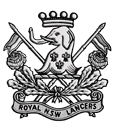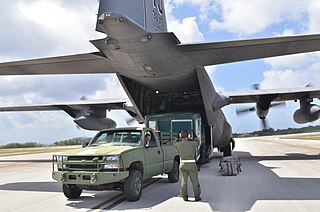
The Haflinger is a small, lightweight, four wheel drive, high mobility cab over vehicle about 2.8 m long and 1.3 m wide, powered by a 643 cc horizontally opposed flat twin, rear mounted air-cooled engine. Weighing around 635 kg (1400 lb), the Haflinger can be lifted by four strong people and yet can carry a load of 515 kg (1135.3 lb). This truck falls into the category of the light utility vehicle. It was produced between 1959 and 1974 by the Austrian manufacturer Steyr-Daimler-Puch.

The Casspir is a Mine-Resistant Ambush Protected Vehicle that has been in use in South Africa since the 1980s. It is a four-wheeled, four-wheel drive vehicle, used for transport of troops. It can hold a crew of two, plus 12 additional soldiers and associated equipment. The Casspir was unique in design when launched, providing for passive mine defence. The main armoured steel body of the vehicle is raised high above the ground, so when a mine is detonated, the explosion is less likely to damage the crew compartment and kill the occupants. The cross-section of the hull is V-shaped, directing the force of the explosion outwards, further protecting the occupants.

The Land Rover Defender is a series of British off-road cars and pickup trucks. They consistently have four-wheel drive, and were developed in the 1980s from the original Land Rover series which was launched at the Amsterdam Motor Show in April 1948. Following the 1989 introduction of the Land Rover Discovery, the term 'Land Rover' became the name of a broader marque, and no longer worked as the name of a specific model; thus in 1990 Land Rover renamed them as Defender 90 and Defender 110 and Defender 130 respectively.

The 101 Forward Control or Land Rover 101FC was a light utility vehicle produced by Land Rover for the British Army. It was not available to the public off the production line, but was as military surplus.

Six-wheel drive is an all-wheel drive drivetrain configuration of three axles with at least two wheels on each axle capable of being driven simultaneously by the vehicle's engine. Unlike four-wheel drive drivetrains, the configuration is largely confined to heavy-duty off-road and military vehicles, such as all-terrain vehicles, armored vehicles, and prime movers.

The Land Rover Wolf is a light military vehicle manufactured by Land Rover in the United Kingdom (UK), based on the Land Rover Defender, introduced in 1994. The Ministry of Defence (MoD) designates the Wolf 90 as Truck Utility Light (TUL) HS, and the Wolf 110 as Truck Utility Medium (TUM) HS, where HS stands for 'High Specification'. Land Rover calls it eXtra Duty (XD).

The 1st/15th Royal New South Wales Lancers is an active Australian Army Reserve Light Cavalry regiment. The regiment has its headquarters at Lancer Barracks in Parramatta, a suburb in Western Sydney, New South Wales. Lancer Barracks is the oldest Military Barracks on mainland Australia and dates from 1819.

The Commercial Utility Cargo Vehicle, later the Light Service Support Vehicle (LSSV), is a vehicle program instituted to provide the United States military with light utility vehicles based on a civilian truck chassis.

The Tatra 148 was a truck produced in Czechoslovakia by the Tatra company.

Otokar Otomotiv ve Savunma Sanayi A.Ş., also known simply as Otokar, is a Turkish bus and military vehicle manufacturer headquartered in Sakarya, Turkey. Otokar is a subsidiary of Koç Holding.

The Land Rover Series I, II, and III, or simply the Land-Rover are compact British off-road vehicles, produced by the Rover Company since 1948, and later by British Leyland. Inspired by the World War II jeep, it was the first mass-produced civilian four-wheel drive car with doors, and an available hard roof. Contrary to conventional car and truck chassis, it used a sturdier fully box-welded frame. Furthermore, due to post-war steel shortage, and aluminium surplus, Land Rovers received non-rusting aluminium alloy bodies, favouring their longevity. In 1992, Land Rover claimed that 70% of all the vehicles they had built were still in use.

Canadian Military Pattern (CMP) trucks were mutually coherent ranges of military trucks, made in large numbers, in several classes and numerous versions, by Canada's branches of the U.S. 'Big Three' auto-makers during World War II, compliant to British Army specifications, primarily intended for use in the armies of the British Commonwealth allies, but also serving in other units of the British Empire.

The Mercedes-Benz Zetros is an off-road truck for extreme operations. It was first presented at the 2008 Eurosatory defence industry trade show in Paris. The Zetros is manufactured at the Mercedes-Benz plant in Wörth, Germany. The truck is designed to be compatible with the C-130 Hercules transport and also fits into a standard German railway carriage. In 2019 Mercedes-Benz presented a facelift of the Zetros with a more powerful engine and a bigger number of variants.

The Dodge WC series is a prolific range of light 4WD and medium 6WD military utility trucks, produced by Chrysler under the Dodge and Fargo marques during World War II. Together with the 1⁄4-ton jeeps produced by Willys and Ford, the Dodge 1⁄2‑ton G-505 and 3⁄4‑ton G-502 trucks made up nearly all of the light 4WD trucks supplied to the U.S. military in WWII – with Dodge contributing some 337,500 4WD units.

Rheinmetall MAN Military Vehicles GmbH (RMMV) is a joint venture company between German companies MAN Truck & Bus AG and Rheinmetall AG. RMMV is part of Rheinmetall's Vehicle Systems Division. Rheinmetall AG holds a 51% stake in RMMV, with the remaining 49% held by MAN Truck & Bus. RMMV was initially a provider to security and armed forces of a wide range of armoured and unarmoured transport, command and role-specific wheeled vehicles, but since 2019 and a restructure has focused on military specific and militarised commercial trucks.

Kahn Design is a British-based company that specialises in the modification of motor vehicles. Founded by Afzal Kahn, the company has its headquarters in Bradford and showrooms in both Chelsea and Kensington in London.

The Long Range Patrol Vehicle (LRPV) is a 6x6 patrol vehicle that was used by the Australian Special Air Service Regiment (SASR) in Afghanistan and Iraq.

The Ineos Grenadier is an off-road utility vehicle designed and produced by Ineos Automotive. It went into production in October 2022. The Grenadier was designed to be a modern replacement of the original Land Rover Defender, with boxy bodywork, a steel ladder chassis, beam axles with long-travel progressive-rate coil spring suspension, and powered by a BMW B58 inline six turbocharged engine.




















